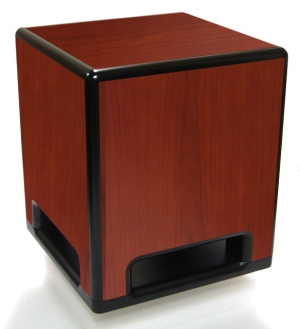|
You are reading the older HTML site Positive Feedback ISSUE july/august 2007
Doctor Sardonicus Addresses Life without Tone Controls … A Rumble of Sub-woofers is like a Murder of Crows… Introduction Life is compromise …I accept that …but I prefer to make my own, rather than having them dictated, especially by audiophiles who at best are a panic- and ennui-stricken bunch. I understand the whole history of "no tone controls," and I also understand the political ramifications for manufacturers who are hoping to avoid the sheep-like flight response audiophiles evidence when faced with supposedly heretical practices (such as adding tone controls to a preamplifier). I see no rational resolution to this problem forthcoming in the foreseeable future. But, necessity is a mother …and her children make for some interesting fixes, one of which I want to share with you. Prime Subs …The Bad Boys of Audio Subs have enjoyed a checkered reputation with audiophiles, with many of the hair-shirt true-believers actually eschewing low bass period, which I find completely nuts. Go ahead and eat your tofu and shredded oat bran …you may live longer, but you sure won't enjoy it much. How that cardboardy, overly damped thock-thock you call audiophile bass can nourish you is beyond me. There is more to life than lifespan, and more to music than just the mid-band. However, I understand there is a price to be paid for bass, just as I know there is a price to be paid for the Oregon Wagyu-ish sirloin steak I plan for dinner tonight. At our current level of technology, producing low bass in a convincing manner generally requires large cabinets, big dynamic drivers, and butt-loads of power. This typically means large floor-standing speakers, which just don't work for everyone. Complicating this is the fact that when we are placing single column speakers, it rarely works out that optimal placement for bass performance coincides with optimal performance in the rest of the spectrum. We get suck outs, standing waves, too much boundary reinforcement, not enough boundary reinforcement …yadda, yadda. Ultimately, we end up picking the location that sucks the least. Compromises …don't ya just hate 'em? So …one solution is/was, to use stand-mounted, two-ways, with sub(s). The classic, life-style sensitive arrangement typically took the form of a stereo pair of diminutive mini-monitors, artfully hidden behind a faux-fichus, with a small, powered sub, tucked away in a corner. We call this "Bosi-fying." All you need is a couple of air-pudding new age recordings, some aroma therapy, a plate of organic tabouli and you are already for an evening with Deepak Chopra or Harry Potter. Just kill me now. Jennifer Crock of JENA Labs has an alternative approach. Using the classic solution of transmission line design, she is putting together a world-class, four column speaker …the primaries being good to about 50Hz, and then two hurking, transmission line cabinets with two fifteens and external amplification (should be good to 17Hz). But, of course, Jennifer's solution is …excessive for all but the most committed full-range audiophiles (mine have been on order). Small subs use tricks …big subs are …big. Placement is a challenge and integration can be very difficult, especially if you are cutting them in relatively high, and particularly with electrostatics and ribbon designs (most of which really NEED bass reinforcement). What is a girl to do? There is hope. There have been improvements and changes which allow for greater flexibility. Layering Subs My current VMPS-30s are primarily ribbon-based. Fast, fast, fast. So, Brian Cheney of VMPS designed the single, 1000 watt big sub with a lot of flexibility in the controls to ease integration. The main towers also have adjustable, external crossovers, which I have grown to adore. But the sub cabinet is huge. Even in my largish room, it has to be tucked back away from the mains. So, at first, I did just that… way in the back, crossed over low; a true sub. But my heart hungered for more. For some time now I have had the charming little ACI Force XL powered stereo subs in various applications throughout my house …and they have performed beautifully, everywhere I have put them. These are terrific pieces for minor money and will take a licking and keep on ticking. I can't compliment them enough.
So, one day I got a wild hair …I dragged the little ACIs into the main system room, and hooked them up along with the VMPS big woofer, but placed them right next to the mains. Then I dropped the crossover point on the large woofer, increased the output level somewhat, and set the ACIs relatively high, but at a very modest output level. Lastly I dialed the mains in flat. How Does it Sound? Horkey Fenorky! The result was astonishing. Even with the mere seventy watts the Ming Da EL-34AB puts out, this combination provides a foundation that feels and sounds like you could drive a truck over it; a concrete and rebar wall of substance and palpable weight that is simply seductive and a lot closer to real music than we typically get in a listening room. Meaty, beaty, big and BOUNCY! Three thousand watts and a significant surface area distributed among the three subs means a whole lotta air being moved around. Add to this, a level of adjustability I could only dream of from conventional tone controls. Now I move forward and back at will among analog and digital sources, tube or solid state amplification and all kinds of music and I am never more than a hair's breath adjustment from optimization …and yes, dammit, my own tastes! Adjustments If you want less warmth, take the small subs down further; more warmth, increase volume. Increased slam and foundation; take the volume up on the back, etc. If you are fortunate enough to have adjustments on your mains …well, isn't that sweet? So, if I am sitting down to listen to vintage rock on vinyl, I know how to dial up more grunt and warmth to offset the thinness of some of these recordings… classical on SACD, dial the warmth down but leave the big mama up for transients. You get the idea. I control the horizontal, I control the vertical! Most importantly, I can maintain the primaries in that precious perilous place where the mid range and highs are best, without giving a fig what it does for bass reinforcement. All this with no real space penalties (all three of the subs occupy "wasted" space around and behind system components). And visually they are unobtrusive (I prefer satin black, like Bunraku actors). Hook Up Now, what about lashing it all up? Even if you are lucky enough to have an extra set of outputs from your pre, you probably don't have two. The simplest thing is a banana plug to RCA cable, with a high quality T connector at the stereo subs, feeding another run to the large mama in the back. PFO's Senior Technical Editor, Jennifer Crock, assures me that, with good cables, the impact on your main amp as a result of hooking two sets of powered subs to the speaker taps is inconsequential. Advantages
Conclusion: I understand there are readers who will simply shake their heads in dismay and think I am completely out of my mind …but there are those out there—and you know who you are—who will bend to the siren's sway, as drool forms (grrrrmmmmm, more bass…). For me, I will extend my middle finger and declare, "Don't give me tone controls, see if I care!"
|


